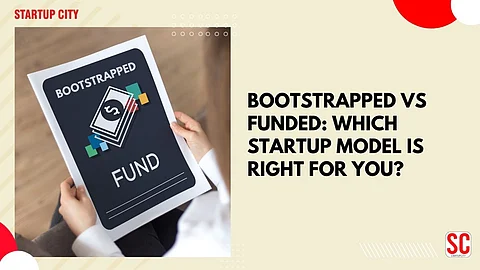

Bootstrapped vs Funded
Imagine this—you’ve got a brilliant idea, a clear market need, and the fire in your belly to build the next big thing. But then comes the fork in the road: Should you bootstrap or seek funding?
As someone who’s worked closely with both bootstrapped warriors and venture-backed visionaries, I can tell you this: there's no one-size-fits-all answer. But what I can give you is clarity.
Let’s break this down so you can choose your path with confidence.
In simple terms, a bootstrapped startup is one that grows using personal savings, customer revenue, or minimal external help. You grow lean, spend wisely, and often wear multiple hats.
Full Control
You call the shots. No investor board meetings. No dilution of vision.
Stronger Foundations
When you grow organically, every rupee counts. You build sustainable, customer-centric businesses.
Valuation Power Later
Investors love efficient businesses. A bootstrapped model often attracts higher valuations later.
Slower Growth
Scaling can be limited without external capital.
Burnout Risk
Managing everything solo can be exhausting
Limited Market Reach
Without marketing budgets, reaching a wider audience is challenging.
Real Example: Take Zoho, one of India’s most successful SaaS companies. Entirely bootstrapped. No VC money. And today, it's valued in the billions.
A funded startup raises money from external investors like angel investors, venture capitalists (VCs), or private equity firms. This capital fuels faster growth and bigger market plays.
Speed & Scale
You can hire fast, market hard, and scale aggressively.
Expert Network
Investors bring mentorship, connections, and strategic guidance.
Market Domination
With enough runway, you can outpace competitors and grab serious market share.
Loss of Autonomy
You’ll have to align with investor expectations and give up equity.
Pressure to Perform
Growth at all costs can compromise product or culture.
Risk of Dilution
Each funding round reduces your ownership stake.
Real Example: BYJU’S, one of India's top edtech unicorns, scaled quickly through massive funding rounds. It went global—but not without the scrutiny that comes with heavy investor involvement.
Before choosing your path, reflect on these five key questions:
If you're comfortable with slow, organic growth, bootstrapping may suit you. But if you're aiming for aggressive market capture, funding can accelerate the journey.
Ask Yourself: Am I ready to trade equity for speed?
Bootstrapped-friendly sectors: Consulting, content creation, SaaS, small-scale D2C.
Funded-favored sectors: Deep tech, edtech, fintech, logistics—anything with high capital needs.
If your product is high-ticket with long sales cycles, you may need funding to survive the waiting period. But if you're targeting B2C with quick conversions, bootstrapping can work.
Funded startups often pivot based on investor feedback. If you want complete creative and strategic freedom, bootstrapping is your calling.
Some founders build to exit. Others build to last. Knowing your end goal is crucial.
Remember: Your startup should serve your life—not consume it.
You don’t have to choose one path forever.
Many founders bootstrap in the beginning, validate their model, and then raise funds when they’re ready to scale.
Freshworks (founded by Girish Mathrubootham) started lean, gained early traction, and later raised funds to go global. Today, it’s listed on the NASDAQ.
Pro Tip: Bootstrap to build value. Fund to scale it.
Key Differences at a Glance
According to Inc42’s Indian Tech Startup Funding Report, Indian startups raised over $10 billion in 2023, down from the previous year due to funding winter.
Meanwhile, bootstrapped startups like Zerodha and Zoho continued to thrive, proving that lean models work—even in turbulent times.
In my experience working with countless Indian founders, here’s what I’ve learned:
There’s no right or wrong model. There’s only what’s right for YOU.
Let your business model reflect your personal values, financial situation, and long-term vision.
If you want freedom, control, and slower but sustainable growth — go bootstrapped.
If you're chasing hypergrowth, market share, and scalability — explore funding.
And if you want both — bootstrap first, fund later.
Either way, don’t compare your Chapter 1 to someone else’s Chapter 20. Your journey is yours alone.
Building a startup is never easy—whether you’re bootstrapped or VC-backed. What matters is clarity, courage, and consistency.
Take the time to reflect, plan, and act with purpose. Whichever path you choose, make sure it aligns with your mission, not just the market.
Let’s build businesses that last—not just ones that raise.